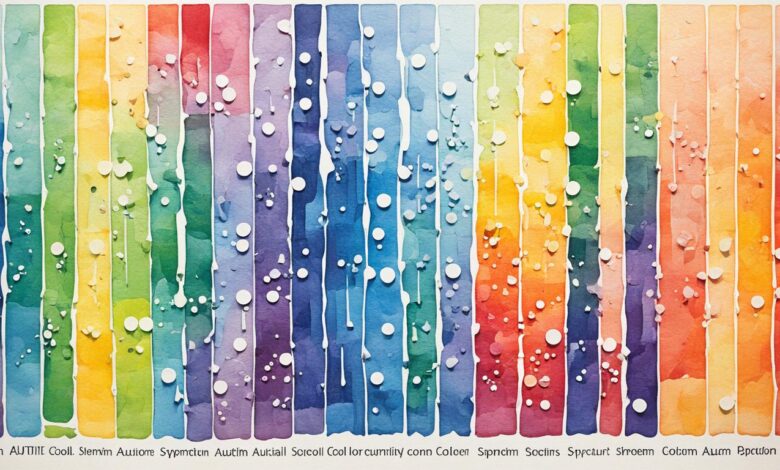Autism Spectrum Disorder Symptoms Guide

In the journey of growing up, we notice specific patterns. These patterns help us understand how we talk, connect, and see the world. Autism Spectrum Disorder (ASD) is one such pattern that has grabbed the attention of both specialists and families. Parents start to notice signs of autism in small moments: like a child not answering when called. Or not smiling back during a game of peek-a-boo. These signs stress the need for a guide on Autism Spectrum Disorder Symptoms. It helps in spotting autism signs and offers support and help.
The story of ASD is filled with unique signs of autism behaviors. These signs can be spotted in quiet moments at home or in the lively chaos of a schoolyard. They help us understand and assist those with autism better. They show when to take a deeper look and listen more attentively. And when to offer the right support for those walking the path of autism.
Although ASD affects everyone differently, sharing these insights is vital. This guide brings together experiences to help everyone understand better. It aims to empower by sharing knowledge about ASD. With this guide, families and professionals can better recognize signs and understand the journey that lies ahead.
Understanding Autism Spectrum Disorder
Today, we’re becoming more aware of developmental disorders. This includes the complexities of Autism Spectrum Disorder (ASD). It’s crucial to understand ASD because it involves conditions related to brain development. These conditions affect how people interact, communicate, and behave in unique ways. Recognizing early signs of autism is key.
It allows for quick response and intervention. This can lead to better outcomes in life for those affected.
What is Autism Spectrum Disorder (ASD)?
Autism Spectrum Disorder is a complex condition. It varies greatly. People with ASD might find social interactions and communication challenging. They might also show restricted and repetitive behaviors. ASD includes autism, Asperger’s syndrome, and other related disorders. It highlights how neurodiversity affects individuals’ daily lives.
The Importance of Early Detection
Spotting autism early in a child’s development is critical. Some signs may appear within the first year. Caregivers who pay close attention may notice slowed development, a sign of ASD. Getting a timely and accurate diagnosis is crucial.
Then, targeted interventions can help shape better development and improve quality of life.
The “Spectrum” Explained
The ‘spectrum’ in ASD covers a wide range of symptoms and their intensity. While all people with ASD show signs, the level of impairment can differ. Some might have mild issues, others severe. This spectrum idea helps us understand each person’s unique needs. It also guides us in providing the right treatments and support.
Symptoms of Autism Spectrum Disorder
Spotting autism symptoms in children can be tricky due to the condition’s wide range. It’s crucial to identify autism signs and symptoms early. This allows for early help, which can improve how well kids do overall.
Social Communication Challenges
Struggles with social interactions are major autism behavior signs. Kids may not share interest or emotions easily. They might avoid eye contact and take longer to start talking. They may find it hard to understand social hints like facial expressions or tone of voice. This makes building friendships tough.
Repetitive Behaviors and Restricted Interests
Kids with autism often repeat actions like rocking or hand-flapping. They might focus keenly on specific subjects or need a set routine. Any change can upset them greatly. This limits their ability to try new things.
Unusual Responses to Sensory Input
Atypical reactions to senses are common autism behavior signs. Some kids might be overly sensitive to textures or sounds but not feel pain as much. They could get very upset in loud places or be really interested in how things feel or sound.
Autism Signs to Watch for in Infancy
Spotting early signs of autism early helps kids get the support they need quickly. Watching for certain signs of ASD in babies is key for parents and doctors. They can take steps early if they see autism red flags. These signs might be in how babies act, talk, and interact with others.
It’s important to see if a baby looks at people. If a baby doesn’t make much eye contact by 9 months, it might be a warning. Babies usually enjoy looking at faces, especially of those close to them.
Not reacting to their name is another sign. By a certain age, babies usually know their name and show it. If they don’t, parents should ask a doctor about it. This is a big clue something’s up.
Sharing feelings is normal for babies too. Not showing joy or interest in people by 9 months can hint at autism. Parents should watch for smiles and laughs that show their baby connects with them.
Here’s a list to help spot signs early:
| Age | Signs to Observe | Notes |
|---|---|---|
| By 6 months | No big smiles or warm, engaging expressions | Infants typically smile when engaged or playing with caregivers. |
| By 9 months | Little or no eye contact, no sharing of vocal sounds or facial expressions | Reflective of difficulty with socio-emotional reciprocity. |
| By 12 months | No response to name, lack of babbling, no back-and-forth gestures | Communication milestones that may be delayed. |
| By 16 months | Minimal or no spoken words | Typical infants communicate with words like “mama” or “dada”. |
| By 24 months | Very few meaningful, two-word phrases | Not including imitating or repeating what is heard from others. |
If you’re worried about your child’s development, talk to a doctor. They might suggest tests or seeing a specialist. Catching and treating autism early can really help a child thrive.
Recognizing Autism Symptoms in Toddlers
During the toddler years, signs of autism become more obvious. This is key for early help. Knowing these signs early can lead parents and pros to the right support. Spotting these signs in a toddler’s actions and how they talk and behave is crucial.
Lack of Social Interactions
Noticing how toddlers interact is a big clue to autism. They may not want to play with others or find it hard to share. They might not catch on to social hints like other kids. Watch if a child tries to make friends or understand others’ attempts to connect. These are signs that might point to autism.
Nonverbal Communication Difficulties
Toddlers with autism might struggle with nonverbal cues. They may not look others in the eye much, or use gestures like pointing. They could find it hard to show feelings with their faces. These struggles with nonverbal communication are signs of autism in young children.
Repetitive Play and Routines
Autism can lead to very repetitive play and a need for things to stay the same. A toddler might get upset over small changes. They may repeat actions with toys instead of pretending with them. Noticing these behaviors can help in understanding autism. It helps in making the right setting for the child’s needs.
Detecting Autism in School-Aged Children
As kids enter school, watching for signs of autism becomes key. These symptoms affect both learning and socializing. Early detection helps provide crucial support and strategies.
Challenges in Social Skills
School-age children with autism often struggle with social skills. Making friends, understanding social signals, and joining in groups can be hard. These difficulties can impact their school performance and friendships.
Communication Hurdles
In school, kids with autism may face communication issues. They might talk in unusual ways, miss the meaning of phrases, or struggle to start conversations. These issues hamper classroom participation and can make them feel left out.
Behavioral Patterns and Learning Differences
Children with autism show unique behaviors and learning approaches at school. They may focus deeply on certain topics or follow strict routines. Coordination problems and different problem-solving tactics can affect their school day.
Are There Autism Symptoms Manifesting in Adulthood?
Autism symptoms are often spotted in kids, but adults can show signs too. This is especially true for those who were never diagnosed. Knowing about autism spectrum symptoms in adults helps. It can explain past struggles, improve relationships, and lead to helpful support.
Adults with autism might find small talk hard or miss the meaning of sayings. They could feel uneasy with certain textures or noises. They may also follow strict routines or dive deep into hobbies. Recognizing these signs of ASD helps adults find the right support at work and socially.
| Symptom Category | Common Signs in Adults |
|---|---|
| Social Communication | Hard time reading body language, preferring to be alone, trouble with friendships |
| Sensory Sensitivities | Too sensitive to lights and sounds, dislike of some clothes, fussy about food textures |
| Repetitive Behaviors | Deep interest in certain subjects, needing routines, not liking changes |
If an adult thinks they might have autism, getting diagnosed is a good step. A proper diagnosis leads to support like social skills therapy. This can make life better and decrease the chance of having mental health issues.
Seeing a healthcare pro who knows about adult ASD is key for those exploring their symptoms. As we learn more about autism, more adults feel seen and empowered by recognizing their autism spectrum symptoms.
Autism Spectrum Symptoms and Co-occurring Conditions
Understanding Autism Spectrum Disorder (ASD) goes beyond just knowing the main symptoms. Research shows that co-occurring conditions are often found with autism. This makes diagnosis and treatment more complex. These conditions affect not only the symptoms of autism but also the life quality of those with autism and their families. Recognizing these conditions helps in giving care that meets all aspects of autism in children.
Physical Health Issues
Kids and adults with ASD might face many physical health problems that go along with autism symptoms. Conditions like epilepsy are common in those with ASD, impacting about one-third of them. Problems with the digestive system are also frequent, making some behaviors worse because of pain or discomfort. Sleep problems are a big worry too. They affect the person with autism and can also upset the family’s routine.
Neurodevelopmental Disorders
Along with autism symptoms, issues like Attention Deficit Hyperactivity Disorder (ADHD) and Rett syndrome are also seen. These disorders share some traits with ASD, which can make diagnosing autism harder or mix up treatment options. It’s crucial for doctors to clearly identify each symptom to aid everyone’s unique needs properly.
Mental Health Challenges
The link between autism symptoms and mental health is important to understand. Many with ASD feel a lot of anxiety and stress, making autism behaviors more intense. Dealing with emotions can be really tough, leading to reactions that others might not understand. This highlights the unique emotional experiences of autistic individuals.
| Condition | Related Autism Behavior Signs | Impact on Daily Life |
|---|---|---|
| Epilepsy | Seizures, sensory sensitivity | May interrupt learning; requires consistent medical monitoring |
| ADHD | Inattention, hyperactivity, impulsive behavior | Creates difficulties in educational settings; causes social challenges |
| Anxiety Disorders | Social withdrawal, increased need for routine | Can make sensory overload worse; limits involvement in social events |
Environmental Factors and Autism Risk
Exploring the causes of Autism Spectrum Disorder (ASD) reveals a complex mix. It shows how vital it is to spot early signs of autism. This involves understanding how genetics and the environment work together. Many experts now believe that certain outside influences might play a role in the development of symptoms of Autism Spectrum Disorder. This has led to a keen interest in environmental factors that could raise the risk of autism, especially if encountered before birth or in early childhood.
Infections during pregnancy are a major concern. Diseases like rubella could interfere with brain development, leading to ASD. Air pollution is also being closely studied. Scientists are looking at its link to problems with brain growth. Another important area is the prenatal use of certain medications. These drugs, which affect hormone levels, are being looked at for their impact on brain development and autism signs.
While genes set the scene, it’s the environmental encounters either in utero or shortly after birth that could turn the key in the ignition of autism’s development.
It’s crucial to remember that vaccines do not raise the risk of autism. This has been confirmed by loads of studies and remains a solid scientific viewpoint. Such findings stress that vaccinations play no part in causing autism. They are critical for children’s health and prevent fears about autism from stopping vaccinations.
| Environmental Factor | Correlation with Autism | Comments |
|---|---|---|
| Viral Infections During Pregnancy | Possible Increased Risk | Evidence suggests some viruses may disrupt fetal brain development. |
| Air Pollutants | Under Investigation | Some studies report associations with developmental delays and ASD signs. |
| Prenatal Medication Exposure | Risk Factor Consideration | Medications affecting hormonal systems could contribute to ASD risk. |
| Vaccines | No Evidence of Increased Risk | Extensive research across populations demonstrates vaccines do not contribute to autism. |
Moving forward with research helps us spot early signs of autism. Understanding how environmental factors relate to autism red flags is essential. It helps guide future parents and doctors. This work also helps in creating ways to prevent ASD, keeping future generations healthy.
Navigating Diagnosis and Professional Evaluation
Spotting autism symptoms early in a child’s life is crucial. Yet, the process to get a diagnosis can be complex and tough for families. They have to be patient and understand the evaluation steps well.
The first check for autism usually happens during well-child visits. Doctors use certain tests to check on a child’s growth and look for autism signs early on. If a child might have Autism Spectrum Disorder (ASD), there’s a detailed check-up next.
This thorough check-up includes a team. It has developmental pediatricians, child psychologists, and speech therapists. They all work together to get a full picture of the child’s skills and challenges.
A proper diagnosis is more than just an identification; it is a tool for understanding and crafting a roadmap to support the child’s development effectively.
The tests for autism can cover many things. They might check how the child thinks, how they communicate, talk to the family, and watch the child in different situations.
| Area of Assessment | Purpose | Methods |
|---|---|---|
| Cognitive Abilities | To evaluate intellectual functioning and learning potential | Standardized IQ tests, developmental level assessments |
| Communication Skills | To examine speech, language, and nonverbal communication | Speech-language evaluations, social communication assessments |
| Behavioral Analysis | To identify repetitive behaviors and social interaction patterns | Direct observation, parent and teacher rating scales |
| Sensory Processing | To gauge responses to sensory stimuli | Sensory profile inventories, observational assessments |
The information from these detailed checks is very valuable. It helps not just in diagnosing ASD but in seeing what special strengths and needs the child has. This understanding is key in creating personalized help for the child and family. This support aims to make life better and help the child grow well.
It is important for parents and caregivers to remember that early diagnosis and subsequent intervention can significantly impact the long-term outcome for children with ASD. The key is recognizing autism symptoms and taking action towards a comprehensive evaluation.
Therapeutic Interventions and Support
Managing Autism Spectrum Disorder (ASD) involves many strategies and support. Parents and caregivers are vital in this journey. They help kids with ASD grow. For best results, we need behavioral therapies, education plans, and family support. These are customized not just to lessen symptoms but to help individuals connect with their world.
Behavioral Therapies
Behavioral therapies are key for treating ASD. They help improve communication and social skills. Techniques like Applied Behavior Analysis (ABA) and Cognitive Behavioral Therapy (CBT) build necessary life skills. These methods aim to better daily functioning and independence, celebrating each person’s unique strengths.
Educational Approaches
Schooling for kids with autism needs to be special. Individual Education Programs (IEPs) and specific classroom setups help meet their unique needs. Trained teachers play a huge part in their learning, helping them succeed in school.
Family Support and Resources
Support for families is also crucial. It gives a strong foundation to those with ASD and their families. Support groups, counseling, and learning materials are key. They offer families knowledge and comfort, knowing they’re not alone in this challenge.








